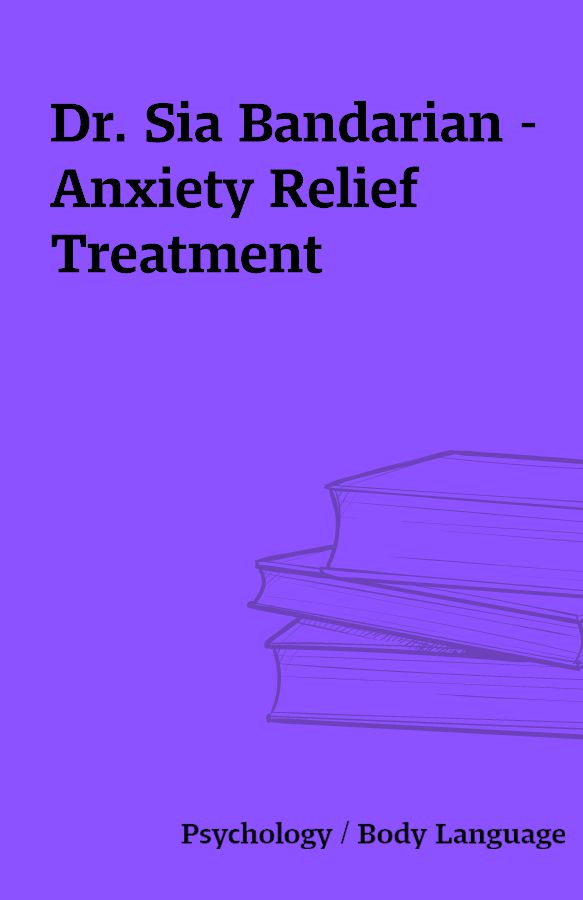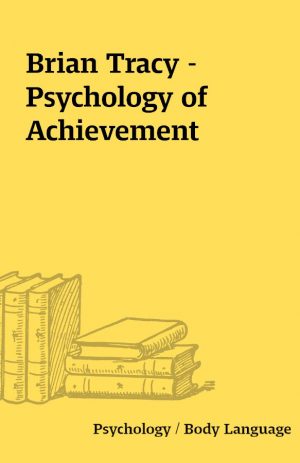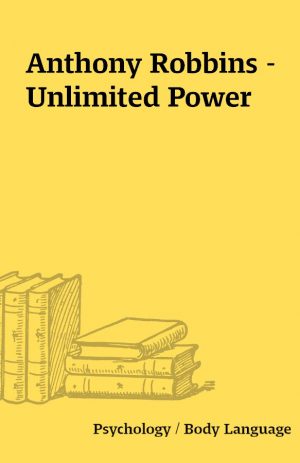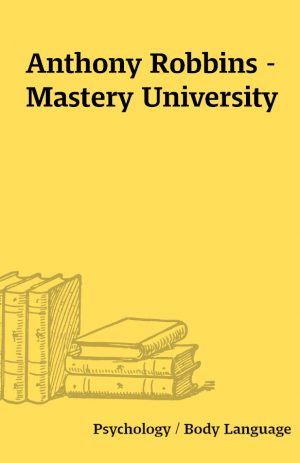Dr. Sia Bandarian – Anxiety Relief Treatment
Dr. Sia Bandarian – Anxiety Relief Treatment
[Audio Rip – 17 MP3]
Description
**** elib Exclusive **** This is the result of a Group Buysharing elsewhere will result in being banned!Dr. Sia Bandarian Anxiety Relief TreatmentFree BONUS For The Will Horton Life Coaching GBDr. Sia Bandarian is a clinical psychologist with many years’ of therapy experience specialising in the treatment of anxiety. He is an expert in behavioural treatment of phobias and offers relief and understanding in his Anxiety Relief Treatment series. Wisemind.com will be releasing Sia’s sessions shortly. Subscribe to our newsletter below to stay in touch.The Path of AnxietyIn this session, Dr Sia Bandarian investigates the path of anxiety. He provides us with an understanding on what anxiety is and identifies the difference between fear and anxiety. Dr Sia explains how and why people experience anxiety in different ways. He examines these various types of anxiety and discusses how they might manifest in our body. Dr Sia shows us skills we can use to identify and monitor our anxiety. He walks us through an effective technique to help us observe our condition without judgements, highlighting the importance of practicing self-compassion throughout this process.The Consequence of AnxietyIn this session, Dr Sia Bandarian investigates the consequences of anxiety. He explains how anxiety is a very common experience, that for many people results with issues in their lives. Dr Sia discusses how anxiety can be isolating and that it is important not to judge ourselves. Through examining the consequences of anxiety, Dr Sia helps us recognise that anxiety is a normal experience and that it can affect people in different ways. He explores three different types of issues that anxiety can cause for us; social anxiety, specific fears and generalised anxiety.The Trigger of AnxietyIn this session, Dr Sia Bandarian investigates the triggers of anxiety. Sometimes it might be clear what situations or objects trigger our anxiety, however sometimes we may not notice or understand our triggers. Dr Sia explains how and why some of our triggers might go unnoticed using detailed client examples. Dr Sia examines four different types of anxiety triggers, including; objects, situations, physical states and memories, assisting us to develop a greater understanding and awareness of our anxiety triggers.Social AnxietyIn this session, Dr Sia Bandarian investigates social anxiety. He examines why some people experience social anxiety and others don’t. We discover different reasons for social anxiety, including the impact adverse past experiences and our childhood may have on our condition. Dr Sia explores different situations that might trigger social anxiety and shows us skills and techniques to help us deal with this anxiety in a healthier way. He helps us challenge our ideas about social situations and our avoidance of these settings, supporting us to work through our anxiety. Dr Sia highlights the importance of being non-judgemental and being kind to ourselves throughout this process. Intense Phobia-like FearIn this session, Dr Sia Bandarian investigates intense phobia-like fear. He explores the different kinds of objects and situations that can cause intense phobia-like fear and discusses how we can monitor these fears. Dr Sia highlights the impact our past traumatic experiences might have on our fears and explains why some people fear certain situations while other people don’t. We find out what situations and objects trigger our fears and discover ways to deal with our fears in a healthier way. Dr Sia guides us through a technique called ‘Imaginal Gradual Exposure’ to help us reduce our fear. Panic AttacksIn this session, Dr Sia Bandarian investigates panic attacks. He offers us an understanding on the nature of panic attacks, assuring us that our panic attacks are not dangerous. Dr Sia examines three different ways we can experience anxiety, these are in our striated muscles, smooth muscles and cognitive perceptual disruption. We might experience any one, or a combination of these types of anxiety during a panic attack. Dr Sia explores different situations that can trigger panic attacks and guides us through a breathing exercise that we can use to immediately reduce our anxiety and reverse the effect that a panic attack has on the body. Psychodynamic Understanding of the Entrance of AnxietyIn this session, Dr Sia Bandarian explores a psychodynamic understanding of the entrance of anxiety. He investigates how we might become anxious due to experiences from our childhood, outlining three different attachment styles; secure attachment, anxious avoidant attachment and anxious ambivalent attachment. We discover how these attachment styles can affect how we experience anxiety as adults and whether our anxiety will become problematic or not. Dr Sia provides us with skills and techniques we can use to start reducing our anxiety in interpersonal situations, highlighting the importance of self-compassion and the significance of recognising and sharing our feelings.The Cycle of AnxietyIn this session, Dr Sia Bandarian investigates the cycle of anxiety. He explores different situations that may cause anxiety and explains how some behaviours which reduce our anxiety in the short-term are not effective and can keep perpetuating our anxiety. Dr Sia examines three main ways we might temporarily reduce anxiety that remains problematic in the long-term. He discusses the physical and mental avoidance of anxiety and the crushing of our fears. Dr Sia provides us with skills and techniques we can use to reduce our anxiety in the long-term rather than the short-term, highlighting the importance of gradually beginning to expose ourselves to our fears.Revealing Our Anxious ThoughtsIn this session, Dr Sia Bandarian investigates the impact that thoughts have on our anxiety. He shows us how we can begin to monitor our anxious thoughts, outlining a technique we can use to identify our thoughts and how they relate to our anxiety in different situations. Dr Sia examines how our fears and anxieties are internal rather than situational and how the intensity of our anxiety comes from inside.Before watching the next session ‘Changing Our Anxious Thoughts’, Dr Sia encourages us to practice the technique we use in this session.Changing Our Anxious ThoughtsIn this session, Dr Sia Bandarian explores how we can begin to change our anxious thoughts. Following on from the previous session ‘Revealing Our Anxious Thoughts’, Dr Sia further investigates our anxious thoughts and how they affect us in different situations. He shows us a technique we can use to evaluate whether our thoughts are helpful or not. Using this technique, we discover how we can challenge those unhelpful, anxious thoughts and replace them with helpful thoughts. Dr Sia encourages us to reach out for the caring person inside of us to help ourselves through this process.Common Unhelpful ThoughtsIn this session, Dr Sia Bandarian investigates common unhelpful thought patterns. We might find it difficult to determine whether a thought is helpful or not. Dr Sia helps us by examining six categories of thought that tend to be unhelpful to us, these are; catastrophizing, over-generalising, jumping to conclusions, mind reading, personalising and minimising. We find out how to identify whether our thoughts fit into any one of these six categories, this can reduce a lot of energy spent having to individually examine every thought.Our Defences to AnxietyIn this session, Dr Sia Bandarian investigates our defences to anxiety. Dr Sia explains what unconscious anxiety is and outlines four different types of defences we might use to reduce the unconscious anxiety we experience. These four different defences are; rationalising, intellectualising, minimising and displacing the source of our feelings. We find out how we can begin noticing our complicated feelings to become aware of the feelings underneath our anxiety. Dr Sia highlights the importance of self-compassion and being able to show care towards ourselves so we can become better aware of our true feelings.Communicating Our Feelings When AnxiousIn this session, Dr Sia Bandarian investigates how we can communicate our feelings when we are anxious. He explores unconscious anxiety and describes how we can recognise the caring person inside of us. Dr Sia helps us discover how to communicate our true feelings to the people in our life. He provides us with examples of situations that show complex feelings to illustrate unconscious anxiety and we find out how to identify our true feelings that lie beneath our anxiety. Dr Sia shows us a simple and effective way to communicate our feelings that supports connection and validation.Core Beliefs WorkWe recommend watching sessions ‘Revealing Your Anxious Thoughts’ and ‘Changing Your Anxious Thoughts’ before viewing this session to ensure you understand anxious thoughts.In this session, Dr Sia Bandarian investigates core beliefs. He discusses how our core beliefs are primarily responsible for our unhelpful anxious thoughts. Dr Sia provides us with three questions we can ask ourselves to identify our core beliefs and shows us a simple technique we can use to reduce the effect that our core beliefs have on our life. He highlights the importance or remaining non-judgemental and practicing self-compassion whilst working with our core beliefs.The Caring SelfIn this session, Dr Sia Bandarian investigates the caring self. He helps us to become more aware of ourselves and our feelings. Dr Sia examines the consequences of our anxiety and assists us to find the caring person inside of us that encourages us to take action, so that we can live a more meaningful and fulfilling life. We discover how we can become more self-aware by looking inside ourselves for parts that contribute to our anxiety and identifying what kind of anxiety is presenting a problem for us. Dr Sia discusses the importance of reaching for the caring person inside of us and outlines how we can begin to care for ourselves without judgements.The Punitive Self Barrier to the Caring SelfIn this session, Dr Sia Bandarian investigates identifies three common barriers that prevent us from caring from ourselves. The first barrier Dr Sia examines is self-neglect, discussing how this part of ourselves may have arisen in childhood. The second barrier is self-punishment, where a part of us is putting ourselves down. Dr Sia explores causes of self-punishment and shows us ways it can manifest in our lives. The third barrier that Dr Sia outlines is self-sacrifice, where we have to put others before ourselves. Dr Sia walks us through an exercise to identify whether there is any part that is preventing us from caring for ourselves.The Relaxed SelfIn this session, Dr Sia Bandarian investigates how to use Progressive Muscle Relaxation (PMR) to reduce our anxiety tension in our body. Dr Sia guides us through a relaxation exercise. We begin by focusing on our breath, and then gradually bringing our awareness to different parts of our body, working through tensing our muscles and releasing any tension we may have there. If you find that your thoughts are interfering with you in this exercise, Dr Sia reminds us not to judge ourselves, this exercise takes practice and over time you will become better at not becoming distracted by any noise.Note: These are series of 10-20 min talks on a variety of topics. Sometimes longer, sometimes shorter.These were videos originally, but I couldn’t rip the videos, so I just managed to get the MP3s. Videos aren’t that important in this case since they were just talking heads anyway.Also, I’ve noticed that some audios have a long silence at the end, then after a while an ‘introduction’ (ie- “we’re going to talk about X”) to the audio you’ve just heard. If you’re getting in some long silence, you can just skip to the next track.And some files are cut short. Initially, I thought it was an error of my ripping process, but I now realize that their audio editing is just faulty and so we have some missing parts, some introductions at the end and some long silences. So this problem is only at the end of some tracks. The rest of the audio seems good.GB thread: Times:Contributors to NLP Life Coaching GB: Ratio-FreeVIP+ – TBAPU+ – TBAUsers – 20 years (get your account up to PU to gain access to exclusive material: upload 25 GB or donate and be a member for 4 weeks)
You must be logged in to post a review.






Reviews
There are no reviews yet.